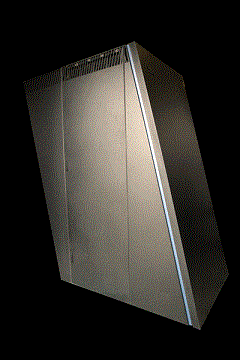At the Computer Farm
Theo Leanse
Jim Austin, who teaches neural computing at York University, lives on a farm in the Yorkshire Wolds. At the top of the hill, behind the farmhouse, are four large sheds that shelter the Jim Austin Computer Collection. He's been collecting obsolete computers for nearly thirty years, and has more than 1000 machines.
‘This IBM mainframe was $8.7 million in 1983,’ he told me when I went to see them. ‘Which in today's money is $24 million. I mean, that's astronomical. And they're scrapped after four years. That's it. Scrap.’ He points to another. ‘The Fujitsu supercomputer, I think it depreciated at £16,000 a week for three years. Then it was zero.’ Behind the IBM and the Fujitsu are more machines: DECs, Wangs. ‘I just take them all home. I preserve them. I just collect them, because I like them. And I've got the sheds, so I just put them in.’
One of the supercomputers in Austin’s collection is a 24-processor Cray T3E, housed in a dark grey wardrobe-sized cabinet with a dramatic red streak running across it. It came from the European Centre for Medium-Range Weather Forecasts in Reading, where the main 800-processor machine had to be checked for vulnerability to the millennium bug. ‘They had to check the weather centre's code, so they bought this. Must have cost them a million quid or something. They tested the code out, checked it was OK for the new year, then scrapped the machine. So we went down there and we hauled it into the back of a lorry.’ Cray made the first real supercomputers. The Science Museum has one; so does the musician Aphex Twin. ‘If there's anything I've got a passion for, it's Crays,’ Austin said. ‘Because they are the ultimate machine. It's like having Ferraris. You have a garage full of Ferraris – I have a garage full of Crays.’
‘They're only a bunch of chips and a bit of wire,’ he said as we walked the long aisles flanked by calculators and bubble-shaped 1970s TV monitors. ‘People have always said we'll have computers as powerful as us someday. And we will. But our intelligence is embodied. It's a part of the environment. You could embody a computer with all the same neurons and all the same circuits as the human brain, but it doesn't experience the same things we do. It doesn't die after a hundred years. It just continues, perhaps for ever.’
As I was leaving, Austin pointed to a two-metre tall, rhomboid black cabinet: an IBM BlueGene/L. ‘What's amazing about that machine is that in 2005 it was the 64th fastest machine in the world. So you think about that – how many machines were actually in the world in 2005? Billions. And that was number 64. It runs at 5.5 teraflops, which is 5.5 million million operations per second. Which is quite extraordinary. And it's right here.’ (The fastest supercomputer in the world now, China's Tianhe-2, runs at 33.86 petaflops per second, which is more than 6000 times as fast as the BlueGene/L.) ‘The unfortunate thing about it is that it's only half-populated. It's only got about 1024 processors in it.’ I asked what happened to the others. ‘Well, the guy who looked after the machine when it was shut down had a penchant for chocolate bars. And if you brought him a chocolate bar, he'd give you a processor board. So obviously you can count the number of chocolate bars he got.’

Comments